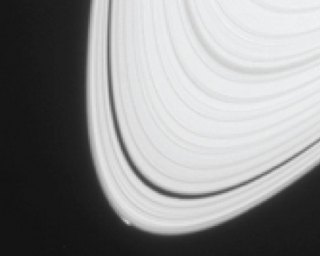A new Saturn moon? Spacecraft spots blip

The space agency's robotic Cassini spacecraft, with an array of cameras and other sophisticated instruments, spotted the icy object in 2013. Cassini has been orbiting Saturn and providing scientists with detailed information about the ringed planet. This latest finding may offer clues about the formation of Saturn's known moons
Images taken with Cassini's narrow-angle camera one year ago show disturbances at the edge of Saturn's A ring -- the outermost of the planet's large, bright rings, according to NASA. One of these disturbances is an arc about 20 percent brighter than its surroundings, 750 miles long and 6 miles wide.
Scientists also found unusual protuberances in the usually smooth profile at the ring's edge. They believe the arc and protuberances are caused by the gravitational effects of a nearby object. Details of the observations were published online April 14 by the journal Icarus.
The icy object is not expected to grow larger and may fall apart. But the process of its formation and its outward movement shed light on the birth of Saturn's icy moons -- including the cloud-wrapped Titan and ocean-holding Enceladus. The object also provides insight into how Earth and other planets in our solar system may have formed and migrated away from our star, the sun.
"We have not seen anything like this before," said Carl Murray, of Queen Mary University of London, and the report's lead author. "We may be looking at the act of birth, where this object is just leaving the rings and heading off to be a moon in its own right."
The object, informally named Peggy, is too small to see in images at this point. Scientists estimate it is probably no more than about a half mile in diameter. Saturn's icy moons vary in size depending on their proximity to the planet -- the farther from the planet, the larger.
Many of Saturn's moons consist primarily of ice, just like the particles that form Saturn's rings. Researchers recently proposed that the icy moons formed from ring particles and then moved outward, merging with other moons on the way.
"Witnessing the possible birth of a tiny moon is an exciting, unexpected event," said Cassini Project scientist Linda Spilker, of NASA's Jet Propulsion Laboratory in Pasadena, Calif.
According to Spilker, Cassini's orbit will move closer to the outer edge of the A ring in late 2016 and provide an opportunity to study Peggy in more detail and perhaps even image it.
Like us on Facebook and tell us what you think.
Related:

